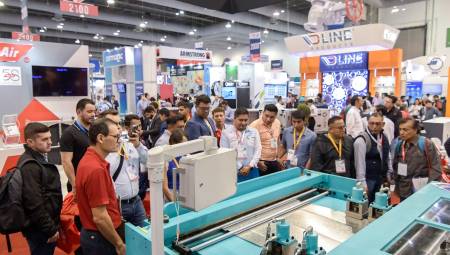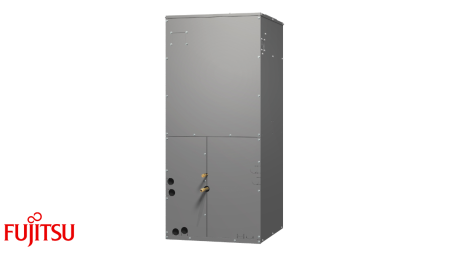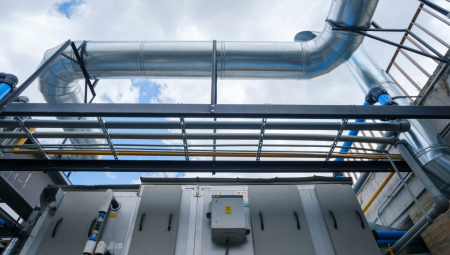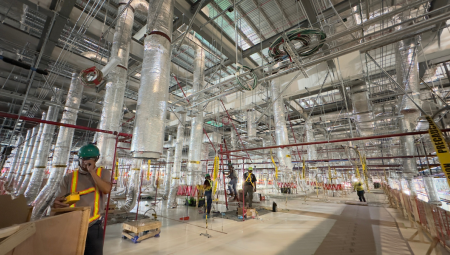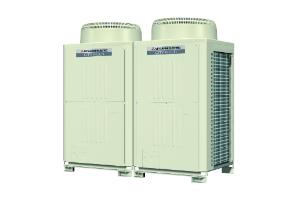 We present two case studies in which Variable Refrigerant Volume Zoning (VRF) systems were installed for schools and universities.
by Mitusbishi Electric
We present two case studies in which Variable Refrigerant Volume Zoning (VRF) systems were installed for schools and universities.
by Mitusbishi Electric
The first of two case studies is that of Gilbert Hall, Pacific University, in Forest Grove, Oregon.
Pacific University, founded in 1849, is listed each year by U.S. News & World Report as one of the best centers of higher education in the United States. Although the university has a small number of students, (just under 3,000), it is large in sustainable practices. In addition to research and academic programs on sustainability, Pacific University has a permaculture project, a bike rental program, as well as local and organic food options. But perhaps the University's most important sustainability project is the development plan for its green campus that includes five LEED-certified buildings.
Following the success achieved with another installation of a VRF zoning system, Pacific University chose the same technology for Gilbert Hall, a new student residence of more than 60,000 square feet with 26 apartments and rooms for 157 students. VRF zoning systems are ideal for student residences because of their flexible design and because they serve different air conditioning and heating needs, according to Brian Shea, project manager for American Heating, Inc., CVAC's contractor for the Gilbert Hall project.
"(VRF) zoning is a wonderful option for today's buildings, where there are smaller and smaller spaces," Shea said.
The Energy Use Index (EUI) is a standard measure of a building's energy management, which compares the energy consumed by similar buildings in identical climates. After monitoring actual performance, Pacific University has calculated that Gilbert Hall achieved an EUI of 46 kbtu per square foot per year. The average EUI of student residence projects in the northwestern United States is 80 kbtu per square foot per year, and, unlike Gilbert Hall, most of these buildings are not air-conditioned. Interestingly, the other building on Pacific University's campus that features VRF zoning technology, Burlingham Hall, also has an EUI of 46 kbtu per square foot per year.
Pacific University officials are pleased with the results. "Gilbert Hall's performance is wonderful," said Chuck Carpenter, a plant engineer at the university.
In addition to obtaining LEED gold certification, the building also achieved the ambitious goals of the Architecture 2030 Challenge in terms of energy efficiency. Gilbert Hall's outstanding energy performance has been repeated year after year, despite the low temperature records of recent winters. Thanks to its experience with the Gilbert Hall building, Pacific University hopes to turn VRF zoning into the go-to technology for all new student residence projects.
Minnie Howard High School
Minnie Howard High School, designed for ninth graders, is located in Alexandria, Virginia. In 2008, the City of Alexandria Public Schools Association (ACPS) hired Hayes Large Architects and B2E Consulting Engineers, both of Leesburg, Virginia, to help turn the more than 50-year-old Minnie Howard campus into a laboratory to test sustainable building technologies that could be implemented throughout the system.
Hayes Large and B2E designed an innovative suite of technologies to create one of the most energy-efficient schools in the country. Such technologies included a creative combination of solar and underground geothermal energy to significantly reduce air conditioning and heating costs, a water-powered VRF zoning system to simultaneously cool and heat the building, water-powered heat pumps, solar heat exchangers, ultra-low flow pipe fittings, and tubular skylights to illuminate classrooms with natural light. corridors and bathrooms.
Forty-two collector solar panels were installed on the school's façade in order to provide water heating and serve as parasols, reducing sun glare and air conditioning costs. For the new geothermal system, 60 wells were drilled 300 feet below the school's parking lot.
Shapiro & Duncan, Inc., Rockville, Maryland., installed the six VRF zoning units located next to the backup boilers, solar heat exchanger, and outdoor offset air unit. Shapiro & Duncan also installed the complex network of pipes connecting the 8,000 feet of pipe linking the closed-loop geothermal water system with VRF's six zoning units.
"The installation went smoothly and the system started the first time without difficulty," said Chris Ott, project manager at Shapiro & Duncan. "Considering there's 8,000 feet of pipe, it's amazing."
In the end, VRF's zoning system exceeded expectations. "Minnie Howard's system is one of a kind," Ott said. "The school went from an outdated cooler that kept water at 40 degrees and two huge, inefficient boilers that kept water at 180 degrees all the time (even when it wasn't needed) to a variable-speed condensing unit combined with a geothermal well system that only works if an indoor air conditioner requires cooling or heating a space. And as if that were not enough, the system has the ability to cool and heat simultaneously and to zone with several condensing units, another milestone in energy savings."
Benefits for schools and universities
Architects, engineers, and education professionals claim that VRF zoning systems are ideal CVAC solutions for schools and universities. Here's why:
Quick Installation: "Given our tight budget, fast-paced schedule, and the overriding interest we had in sustainability, VRF's zoning system was the perfect choice. It was installed quickly, the tight deadlines of renovation and new construction were met, for example, installation during the summer holidays." - Kurt Haapala, associate at Mahlum Architects, speaking about the installation at Burlingham Hall, Pacific University, Forest Grove, Oregon.
Indoor air quality: "Thanks to a virtually zero level of pollutants and reduced humidity, indoor air quality improved enormously, so much so that a student with severe asthma was finally able to return to classes in the building." - Lawrence Kicak, CVAC operations manager and refrigerant compliance at Emory University, Atlanta, Georgia.
Chiller expansion function: "We were also impressed by the possibility of using the system as a backup unit for our gas boilers. Vermont has high electricity rates and this backup helps us save energy costs." - Holly Mussatti, physical staff director, Champlain College, Burlington, Vermont.
Noise reduction: "Our teachers love improvements in the pedagogical environment. With the old window units the teachers had to scream and stay cool or turn off the units in order to be heard and endure a suffocating classroom." - Hal Holmes, assistant superintendent of Jackson County Schools, Vancleave, Mississippi.
Individual checks: "Over the course of the last four years, we have received very favourable feedback from students from each of the three residences. Everyone likes the individual controls of the rooms." - Randy Scholnick, director of sales for Sirius Mechanical, speaking about the installation at Harvey Mudd College, Claremont, California.
LEED Certification
Universities and institutes of higher education in the United States are recognized as intellectual leaders of the most important social and scientific trends, so it is not surprising that they tend to be models of environmental management. A report by the U.S. Green Building Council (USGBC) reveals that of all LEED-certified buildings, about 14% are on college campuses and that 3,430 higher education projects are registered or certified by LEED assessment systems.
With a view to LEED certification, VRF zoning systems can contribute a large number of points in the Energy and Atmosphere (EA) and Indoor Environmental Quality (IEQ) categories for the following aspects: new plants and major renovations; development of structure and wrapping; existing buildings; schools (new plant and remodeling); commercial premises (new plant and remodeling); and health service facilities (new plant and refurbishment). Buildings can earn points in the following categories for all LEED certifications:
Energy and Atmosphere (EA)
Prerequisite: Fundamental reception of the building's energy systems. A VRF zoning system meets this prerequisite as it has an integrated control system that provides for verification, control and reporting tests.
Prerequisite: Minimum energy efficiency. VRF's zoning technology provides the means to exceed the guidelines of ASHRAE 90.1-1999, thus meeting the minimum energy efficiency prerequisite.
Credit: Optimization of energy efficiency. The energy efficiency, which in itself offers the VRF zoning system, allows to make great energy savings above the ASHRAE 90.1 standard. Inverter technology, heat recovery and zone controls provide optimal opportunities for energy savings.
Credit: Measurement and verification. Integrated VRF controls and maintenance software offer the ability to continuously monitor and report on the building's energy management in order to earn this credit.
Quality of the Indoor Environment
Prerequisite: Minimum indoor air quality. VRF zoning systems can meet this prerequisite (Sections 4 to 7 of ASHRAE 62.1- 2004) through indoor units with ventilation connections or specialized integrated outdoor air systems.
Credit: Outdoor air ingress monitoring. Controls for CO2 monitoring can be incorporated into a VRF system. Also, certain door units use MERV 8 filtration to meet the credit.
Credit: Controllability of systems – Thermal comfort. The VRF's zoning function allows occupants to control the system with wall remotes.
Credit: Thermal comfort - Design. VRF zoning systems and building wrapping must be designed to meet the guidelines of ASHRAE 55-2004, which stipulates the thermal comfort conditions for human occupancy.
Credit: Thermal comfort - Verification. When properly designed in a building, VRF zoning systems provide temperature and humidity control, in accordance with asHRAE 55-2004 guidelines.
VRF zoning systems can also contribute to the specific achievement of a school certification and the obtaining of a specific credit.
Prerequisite: Minimum acoustic environment. Many indoor units with VRF zoning system have shown noise measurements equal to or less than 45 dB(A).
VRF zoning systems are sustainable and economical CVAC solutions that offer many benefits, including energy savings, increased comfort, flexibility in design and installation, decreased maintenance costs, and quiet operation. Equally important is the fact that VRF technology provides the opportunity to earn a significant number of points to earn LEED certification.
If you'd like to learn more about how VRF zoning systems can help earn LEED certifications, visit the U.S. Green Building Council website www.usgbc.org.







